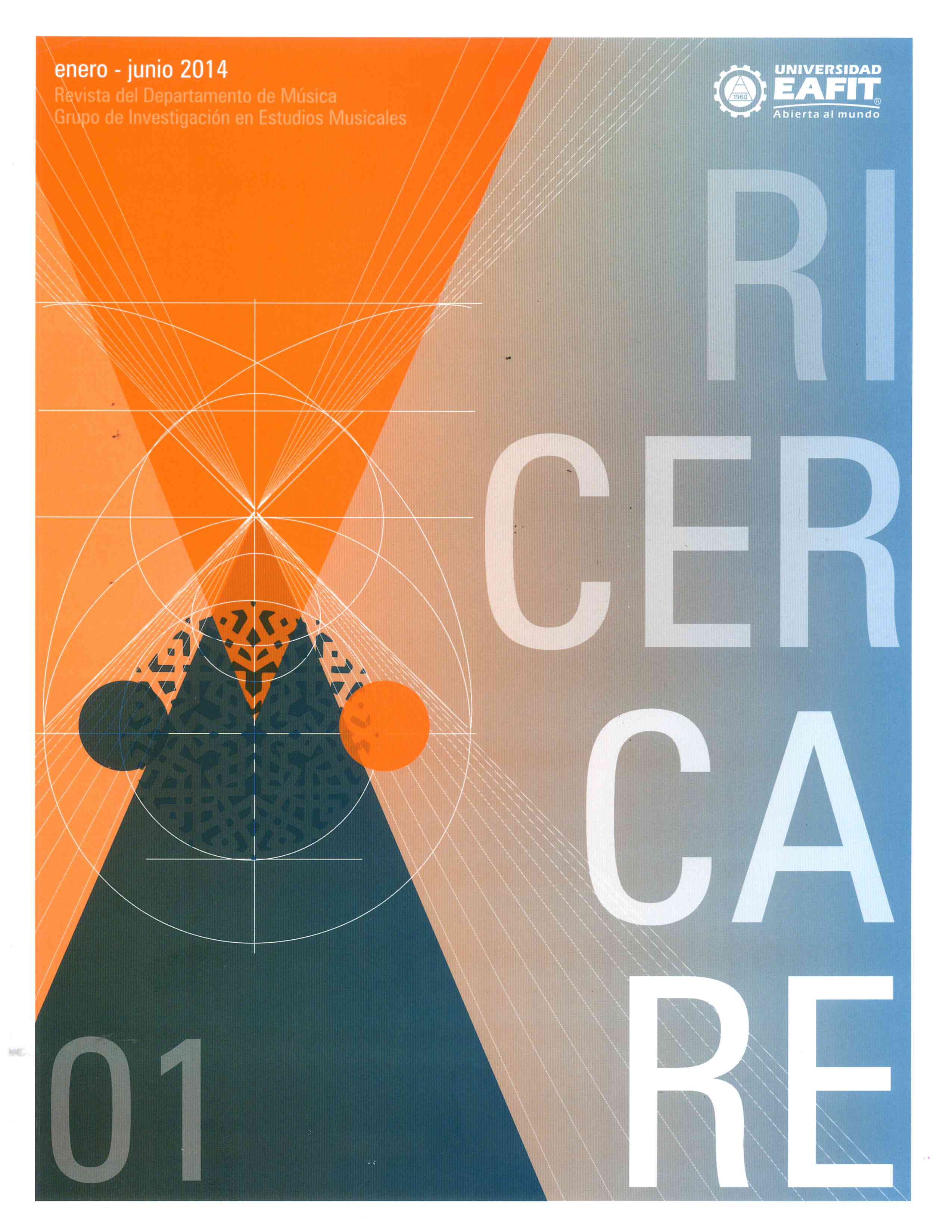Introducción a la acústica de la bandola andina colombiana
Main Article Content
Keywords
Bandola andina colombiana, Acústica musical, Análisis modal, Acople modal, FEM
Resumen
En este artículo, presentamos la bandola andina colombiana dentro del contexto de la acústica musical. Mencionamos algunos de los fenómenos físicos involucrados en la generación del sonido y la relación con la construcción del instrumento. Aprovechando el parecido con la guitarra — en origen y construcción — utilizamos un modelo mecánico simplificado para el estudio de las resonancias acopladas, el cual se alimentó de los resultados obtenidos por simulaciones con el método de los elementos finitos.
Descargas
Referencias
Beranek, L. L. (1986). Acoustics. Acoustical Society of America. ISBN 0-88318-494-X.
Bernal, M. (2003). Cuerdas más, cuerdas menos: una visión del desarrollo morfológico de la bandola andina colombiana. Monografía. Universidad Pedagógica Nacional, Bogotá, Colombia.
Buen, A. (2006). “Violin Acoustics History - a brief introduction”. Joint Baltic-Nordic Acoustics Meeting. Gothenburg, Sweden. Recuperado de: http://www. akutek.info/Papers/AB_Violin_acoustics_history.pdf
Caldersmith, G. (1981). “Plate fundamental coupling and its musical importance”. Catgut Acoustical Society Newsletter, 36, pp.21–27.
Christensen, O., y Vistisen, B. B. (1980). “Simple model for low-frequency guitar function”. Journal of the Acoustical Society of America, 68, pp.758–766.
Christensen, O. (1982). “ Qualitative models for low frequency guitar function”. Journal of Guitar Acoustics, 6, pp.10–25.
Cohen, M. R., y Drabkin, I. E. (1948). A SourceBook in Greek Science. New York: McGraw-Hill Book Co., Inc.
Cortés J., y Bernal, M. (2002). “La bandola andina colombiana en las paradojas de la música popular y la identidad nacional”. IV Congreso de la Rama Latinoamericana de la IASPM. México.
Dickens, F. T. (1981). “Analysis of the first and second vibration modes in a guitar using an equivalent electrical circuit”. Catgut Acoustical Society Newsletter, 35, pp.18–21.
Elejabarrieta, M. J., Ezcurra, y A., Santamaría, C. (2002). “Coupled modes of the resonance box of the guitar”. Journal of the Acoustical Society of America, 111, pp.2283–2292.
Ewins, D. J. (2000). Modal Testing: Theory, practice and application. Second Edition. Research Studies Press LTD. ISBN 0 86380 218 4.
Ezcurra, A., Elejabarrieta, M. J., y Santamaría, C. (2005). “Fluid-structure coupling in the guitar box: numerical and experimental comparative study”. Applied Acoustics, 66(4), pp.411–425.
Firth, I.M. (1977). “Physics of the guitar at the helmholtz and first top-plate resonances”. Journal of the Acoustical Society of America, 61(2), pp.588–593.
Fletcher, N. H., y Rossing, T. D. (2010). The physics of musical instruments. 2nd Edition. Springer.
Hutchins, C. M. (1981). “Acústica de las tablas del violín”. Scientific American 245, pp. 170. Recuperado de http://www.afhalifax.ca/magazine/wp-content/sciences/harmoniemusicale/Article_by_CMH_on_Violin_plates.pdf
Hutchins, C. M. (1983). “A history of violin research”. Catgut Acoust. Soc. J. 4(1), pp.4–10.
Jansson, E. V. (1971). “A study of the acoustical and hologram interferometric measurements on the top plate vibrations of a guitar”. Acustica, 25, pp.95–100. Recuperado de:
http://www.speech.kth.se/prod/publications/files/
qpsr/1969/1969_10_2-3_036-041.pdf
Jansson, E. V. (1977). “Acoustical properties of complex cavities and measurements of resonance properties of violin-shaped and guitar-shaped cavities”. Acustica, 37, pp.211–221.
Kinsler, L. E., Frey, A. R., Coppens, A. B., y Sanders, J. V. (2000). Fundamentals of Acoustics. John Wiley y Sons, Inc., 4th Edition. ISBN 0-471-84789-5.
Knott, G. A., Shin, Y. S., y Chargin, M. (1989). “A modal analysis of the violin”, Journal Finite Elements in Analysis and Design- NASTRAN, 5, pp.269–279.
Lindsay, R.B. (1966). “The story of acoustics”. J. Acoust. Soc.Am.,39, pp. 629–644.
Marshall, K. D. (1985). “Modal analysis of a violin”. Journal of the Acoustical Society of America, 77, pp.695–709.
Meyer, J. (1982). “Die abstimmung der grundresonanzen von gitarren”. Das Musikinstrument, 23, pp.179–186. Traduction of Journal of Guitar
Acoustics, 19(5).
Rao, S. S. (2007). Vibration of continuous systems. New Jersey: John Wiley and Sons, Inc. ISBN-13 978-0-471-77171-5.
Rodríguez, S. E. (2010). Planteamiento de una metodología de medida acústica en la bandola andina colombiana. (Reporte interno). Universidad EAFIT. Medellín.
Rodríguez, S. E. (2010). Caracterización acústica de la afinación y los modos normales de vibración en bandolas colombianas. (Reporte interno). Universidad
EAFIT. Medellín.
Rodríguez, S. E. (2012). Numerical analysis of the modal coupling at low resonances in a colombian andean bandola in C using the finite element method. (Tesis de pregrado). Ingeniería Física, Universidad EAFIT. Medellín.
Rodríguez, S. E., y Guarín, N. (2012). FEM simulation of normal modes of vibration in a colombian andean bandola in C. (Reporte interno Semilleros de Investigación). Universidad EAFIT. Medellín.
Rodríguez, S. E., y Guarín, N. (2013). “Finite Element Analysis of the Colombian Andean Bandola”. (En preparación).
Ross, R. E., y Rossing, T. D. (1979). “Plate vibrations and resonances of classical and folk guitars”. Journal of the Acoustical Society of America, 65, S72.
Rossing, T. D. (Ed.)., (2007). “Chapter 2: A Brief History of Acoustics”. En: Rossing, T. D. (Ed.), Springer Handbook of Acoustics. Springer. ISBN 978-0-387-30446-5.
Rossing, T. D. (2010). The Science of string instruments. Springer. ISBN 978-1-4419-7109-8
Rossing, T. D., Popp, J., y Polstein, D. (1985). “Acoustical response of guitars”. En: Proceedings SMAC83, pp. 311 – 332. Stockholm: Royal Swedish Academy of music.
Ruiz-Boullosa, R. (1997). “Algunas Notas sobre la acústica de la guitarra clásica”. Revista Mexicana de Física, 43(2), pp. 300-313.
Ruiz-Boullosa, R., Orduña-Bustamante, F., y Pérez- López, A. (1999). “Tuning characteristics, radiation efficiency and subjective quality of a set of classical guitars”. Applied Acoustics, 56, pp.183-97.
Ruiz-Boullosa, R. (2002). “Vibration measurements in the classical guitar”. Applied Acoustics, 62, pp.311-322.
Torres, J. A. (2006). Modos de vibración simulados por computadora y experimentales de una tapa de guitarra en sus etapas de construcción. (Tesis de maestría). México: Universidad Nacional Autónoma de México.
Torres, J. A., y Ruiz-Boullosa, R. (2008). “Identificación a simple vista de patrones de vibración de una tapa de guitarra”. Acústica. Portugal: Universidad de Coimbra.
Williams, E. G. (1999). Fourier acoustics: sound radiation and nearfield acoustical holography. Access Online via Elsevier.
Zienkiewicz, O. C., Taylor, R. L., y Zhu, J. Z. (2005). “Coupled Systems”. En: The Finite Element Method: Its basis and fundamentals. Sixth Edition. Elsevier.

